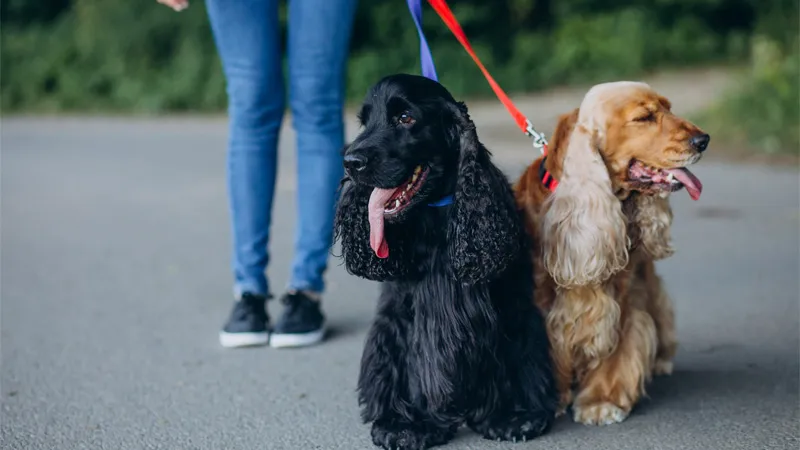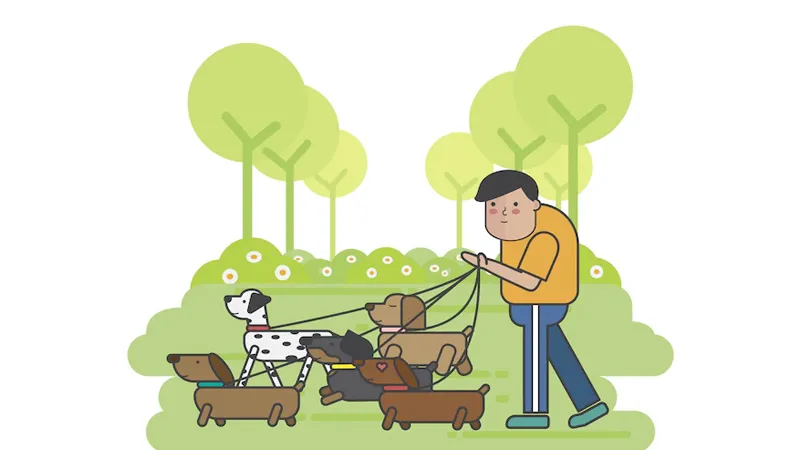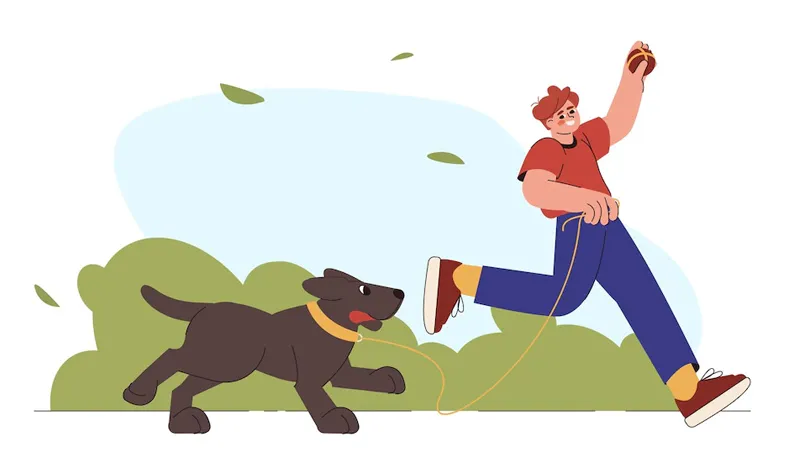Animal Care
How to Become a Dog Walker – A Definitive Guide
Dogs are man’s best friend. Our furry friends love walking. Being a dog walker entails looking after them for a period of time, bringing them for a walk, and receiving compensation in exchange. As a result, the required procedures here are somewhat standardised, and you do need a clear understanding of them.
Table of Content
- So let’s start our discussion on how to become a dog walker.
- What are the Typical Duties of a Dog Walker?
- How to Become a Dog Walker?
- Animal Husbandry Courses
- City and Guilds Qualifications
- Earn Work Experience by Applying to an Established Company
- Learn How to Advertise Your Business and Find Clients if You Freelance
- Learn About Additional Dog Walking Needs to Improve Your Employability
- Detailed Instructions for Starting a Dog Walking Business
- Personal Qualities Required for Becoming a Dog Walker
- Additional Criteria for Dog Walkers
- Salary and Career Progression
- Frequently Asked Questions [FAQ]
- Conclusion
- What to Read Next:
So let’s start our discussion on how to become a dog walker.
Dog walking is more than just a stroll in the park. You must be prepared to take responsibility for someone else’s pet, and they are not always on their best behaviour, so it is a job that must be taken seriously.
However, there is nothing to be worried about as your training will prepare you for all sorts of situations.
There are several ways to obtain a career as a dog walker. This write-up will cover everything you need to know about being a dog walker, including the qualifications you’ll need, income ranges, and helpful advice.
Though, before we get into the specific requirements for being a professional dog walker, it’ll be beneficial for us to start with the basic tasks of a dog walker.
What are the Typical Duties of a Dog Walker?
So, what exactly qualifies as dog walking? Your typical days may be like follows:
- Walking dogs, either on or off the lead.
- Playing with dogs and keeping them engaged.
- Taking dogs from their owners’ homes, preferably while the owner is not around.
- Feeding or brushing them if you provide these services or if the owner requests them.
- Performing administrative tasks such as invoicing, marketing your services, and getting clients.
What do you need to be a dog walker? Let us now look at the requirements needed to be a dog walker.
 Interested to take an Animal Care Worker Course?
Interested to take an Animal Care Worker Course?
How to Become a Dog Walker?
Being a dog walker can be a great career for someone who likes animals, so here’s our step-by-step guide. It includes everything from how to get started as a dog walker to marketing your dog walking business.
Develop the Required Skills to Position Yourself as a Qualified Candidate
If you’re wondering what it takes to become a dog walker, you should know that there are no established dog walker qualifications.
However, it can be advantageous to select topics in high school or college that can assist launch your career in the appropriate way. Most importantly, you’ll have confidence that you’re providing excellent service and that you can truly care for the animals under your supervision.
Look for courses that teach you about animal nutrition and behaviour. Even simple training that allows you to detect health concerns can be incredibly beneficial if you walk dogs or provide residential care for them.
Understanding animal behaviour can be helpful when dealing with –
- nervous,
- shy,
- or frightened pets

Dog Behaviour, Dog Grooming and Dog First Aid Course Online Training Diploma
- Accredited Courses
- Tutor Support Included
- 3 Installment Plan at checkout
- 14 Days Money Back Guarantee
Animal Husbandry Courses
Many colleges offer animal husbandry courses that help you distinguish yourself from the other candidates as a dog walker. You can add to your resume some of the training and certifications regarding-
- animal first aid,
- animal care,
- and animal behaviour.
City and Guilds Qualifications
These City and Guilds qualifications are available in colleges and centres around the country:
| Level 2 Certificate Of Technical Competence In Dog Walking |
| Level 2 Certificate of Technical Competence in Pet Sitting |
| Level 2 Certificate of Technical Competence in Animal Health, Husbandry and Handling |
| Level 3 Certificate of Technical Competence in Animal Nutrition |
Level 3 Award in Dog Walking and Pet Sitting for Professionals
The Level 3 Award in Dog Walking and Pet Sitting for Professionals is an Ofqual-regulated certification that is an excellent way to start if you wish to run a dog-walking or pet business. There are no prerequisites for taking this course. However, you must be at least 16 years old.
This course’s two mandatory modules address a variety of fundamentals for dog care and well-being.
It will teach you the following:
- Duties and obligations of a professional dog walker and pet sitter.
- Understand the policies, processes, and legislation involved.
- Discover customer needs for dog walking and pet sitting services.
- Learn about health and safety regulations and how to reduce dangers.
- Examine the codes of practice for carrying animals in a vehicle.
- Explore dog breeds and behaviours.
- Learn about canine care and well-being.
- Learn about dog behaviour and how to recognise and respond to different cues.
- Learn how to care for other small animals for a pet sitting company.
- Understand how to develop and run a small animal business.
Earn Work Experience by Applying to an Established Company
Well-established firms provide pet sitting and dog walking services in various parts of the country. Many of these companies provide short-term or part-time work opportunities, which can be an excellent way to get experience.
Having this kind of experience on your resume is also useful if you later decide to set up a dog walking business. By registering with a well-known organisation, you can relieve some of the strain of finding your own clients.
You may expand your knowledge and experience over time to perform more freelance dog walking in your neighbourhood.
Learn How to Advertise Your Business and Find Clients if You Freelance
Setting up a business on your own might be challenging, but it can eventually help you find meaningful and long-term employment as a dog walker.
- Study competitors in the region to assist in developing a price strategy. This can also assist you in learning how to market yourself effectively through local advertising.
- Consider what additional types of services you can be able to provide to differentiate yourself. If you provide pet sitting or grooming services, you can easily expand your client base too.
Learn About Additional Dog Walking Needs to Improve Your Employability
Pet owners love their dogs and want to be ensured that they are entrusting them to someone trustworthy. In some cases, your clients might allow you unsupervised access to their homes or gardens.
While a strong affection for animals is helpful, you can also take additional practical efforts to demonstrate that you’re someone they can trust to enter their house and care for their pet.
Presenting a completed Disclosure and Barring Service (DBS) check is one of the most apparent things you can do. This can be obtained at the government’s website. To obtain a DBS check,
- you have to submit basic information such as your last five years’ addresses and national insurance number.
- you must also provide copies of your identity documents.
However, once completed, the DBS certificate demonstrates that you do not have a criminal record.
Detailed Instructions for Starting a Dog Walking Business
Being self-employed and starting your own business allows you to be your own boss and pick your clients, but the fact is that you have to put in the effort to reap the benefits.
Here’s what you should do:
Write a Business Strategy for Dog Walking
Writing a business plan before you begin will assist you in identifying-
- the opportunity,
- your competitors,
- and how you will really manage your company.
Doing so at the start of the process allows you to answer all of the pertinent questions and address any potential issues.
Obtain All Necessary Checks
A Criminal Record Check is required if you are carrying a dog owner’s keys and entering their home. For employment in England and Wales, a standard Disclosure and Barring Service check costs £18.
If you’ve resided at your current location for less than a year, you may apply for a Criminal Record Check for £65 through NarpsUK.
Understand the Rules and Restrictions for Dog Walking
NarpsUK provides a wealth of information on how to establish a dog walking company, and they’re particularly useful in knowing the important rules and regulations.
Among these rules are the following:
- Meeting owners prior to the first booking.
- Limiting the number of dogs walked to no more than four at a time.
- Keeping records of all work completed.
- Protecting clients’ personal information.
- Ensuring all dogs in public wear a collar with the owner’s name and address on it.
- Cleaning up faeces (failure to do so could result in a £1,000 fine).
- A license is required if you also provide dog boarding services.
You are not required to join NarpsUK, but doing so offers you access to a wealth of information and assistance in starting a dog walking company. Informing your clients that you have a dog walking certification can provide them with assurance.
Consider Business Insurance
Dog owners entrust you with their dogs. Therefore they want you to be cautious and dependable. Obtaining a tailored dog walking insurance policy or public liability insurance can help demonstrate to clients that you are serious about your business.
Create a Contract for Dog Walking Services
A written contract between you and your clients is a great idea since it may protect your company if there are any concerns or disagreements.
Your contract should include the following clauses:
- a statement of the service and your obligations,
- how much the customer will pay you,
- and when and how far the walks will be.
- You can also give information on the dog, such as whether it has any special requirements.
Marketing Policy
Business doesn’t normally fall into your lap like a needy chihuahua, so you’ll need to spread the news to potential clients. Consider the following options:
Flyering |
Most owners are likely to be in your region. |
Referrals |
If the owner’s friend recommends you, you’ll gain their trust. |
Social Media |
We all know that dog videos are popular. You’ll have plenty of opportunities for regular pet updates on your walks, which can be a great way to illustrate what you do. |
Maintain Your Relationships with Your Current Clients |
If you provide the greatest service, they will refer you to their dog-owning friends. |
Personal Qualities Required for Becoming a Dog Walker
Although certifications and expertise in animal care are required, a number of personal traits will undoubtedly help you establish yourself as a professional dog walker.
Here are a few examples:
An Affection for Animals
This encompasses difficult and shy dogs who may be wary of new persons.
Attention to Detail:
Dog walkers must pay close attention to details such as
- the breeds of dogs they are caring for,
- the client’s instructions,
- state and local legislation,
- and any support needs dogs have.
Communication
Dog walkers must be able to communicate with customers in order to
- accept directions,
- schedule appointments,
- and keep clients informed.
They can also converse with dogs through orders and nonverbal cues.
Interpersonal Skills
Dog walkers must be able to watch and sympathise with dogs, as well as have some people skills. They must be able to sympathise with and acquire the trust of their clients.
Top Courses of this Category
Problem Solving
Depending on the circumstances, dog walkers must be able to calm their clients’ dogs and prevent conflicts with other dogs or animals altogether.
Organisation, Record-keeping and Scheduling
Dog walkers must keep detailed records for their customers, noting any needs or requests and ensuring that they or one of their coworkers is accessible.
Technical Knowledge
Dog walkers must be familiar with the usage of-
- animal restraints,
- animal cages,
- animal control,
- feeding,
- and first aid treatments.
High Energy Levels and a Willingness to Go Outside in All Weather Conditions
If you want to work as a dog walker full-time, you must commit to walking your customers’ dogs regardless of the weather. Being present at work regardless of the weather demonstrates your dedication to your job.
Additional Criteria for Dog Walkers
Having a driver’s license and access to your own vehicle allows you to go further to contact clients. You may also use your car to go to dog-friendly parks or other sites for walks, which is especially useful if your customers live in regions with limited access to safe, open spaces.
Some organisations provide professional canine care credentials and certificates in first aid and dog breeding management. These are not required but can be advantageous if you intend to develop your dog walking business.
If you work with dogs as a freelancer, such as a dog walker, you might consider acquiring specialised insurance. This protects you in the event of any unanticipated difficulties with your clients or a dog in your care, and it can also safeguard your business.
Salary and Career Progression
So, how much should you get paid for dog walking? The amount you receive varies widely based on your clients, but the average hourly rate is roughly £11.50.
This implies that if you worked a 40-hour week, you’d make roughly £24,000 per year, with higher earners receiving around £32,000 per year. You have the ability to determine your own fees as a self-employed dog walker.
However, part of this will likely rely on –
- where you live,
- how much competition there is,
- and how popular dog walking services are.
Busy metropolitan professionals with disposable income but little time may be prepared to pay extra for dog walking, but you may face strong competition.
There may be fewer dog owners in need of walking services in a calmer location, but if you’re the best and most trustworthy dog walker in the region, you may still carve out a niche. You might also explore improving your services to generate more money and reach a larger range of clients.
Popular choices for experienced dog walkers with a large customer base include-
- dog grooming,
- dog training,
- and dog sitting, which involves spending time with dogs, either taking them into your own house or providing residential care while their owners are away.
Frequently Asked Questions [FAQ]
In 2022, how much are dog walkers earning in the UK?
In 2022, the average dog walking cost is roughly £14 for a 45-minute to hour-long walk in the UK. It represents a 15% rise over the previous year.
Do I need a dog walking license in the UK?
A dog walking license, qualification, or certification is not currently required in the UK. With no common minimum qualifications in place, all you need to legally operate a successful dog walking company is to have an affection for dogs and enough spare time.
How much should I charge for dog walking in the UK?
You might charge anything from £5 to £25, depending on numerous parameters such as location, walk duration, frequency, and time of day.
Conclusion
As you can see, walking dogs for a career entails more than just pulling on a leash and getting some exercise. You must be a dog lover who understands canine behaviour and is ready to operate a business.
However, it can be rewarding work for a determined person who is well-organised, competent, and human and furry client-oriented.
Hopefully, this write-up on how to become a dog walker has provided you with the complete guidance concerning how to begin your professional dog walking career and gradually build a successful business in this sector.













